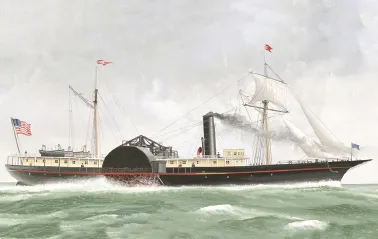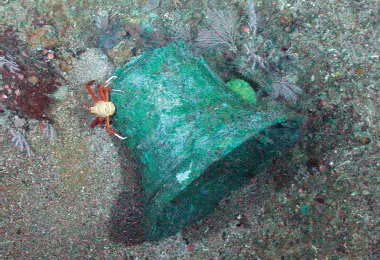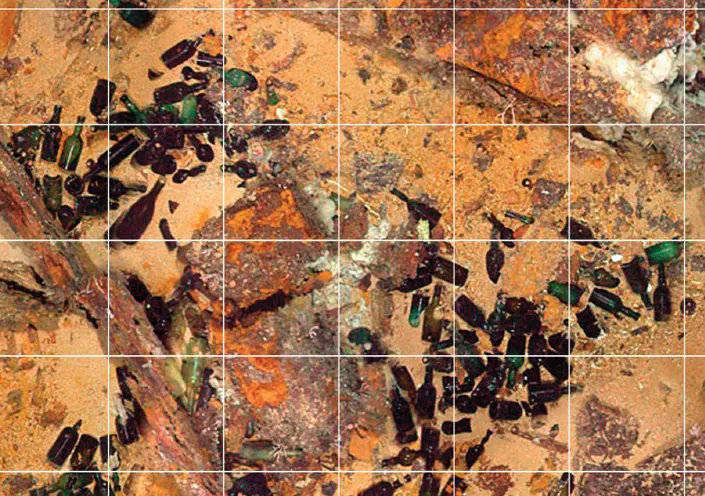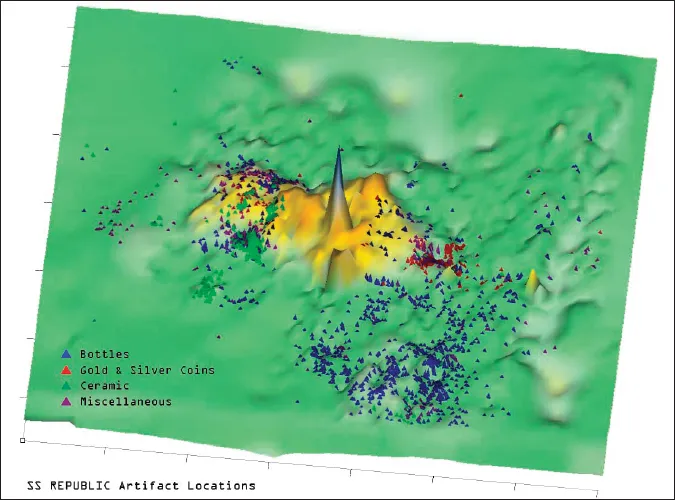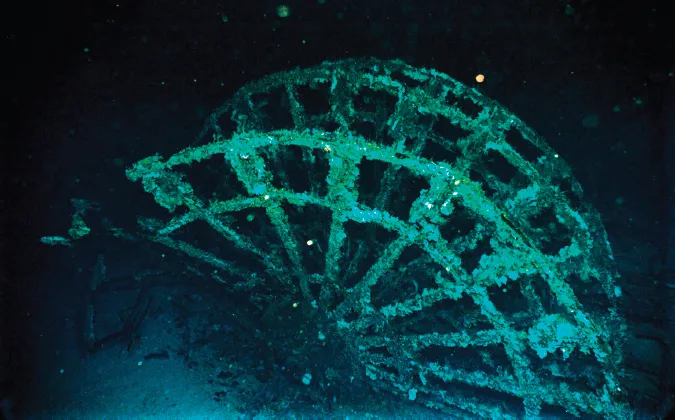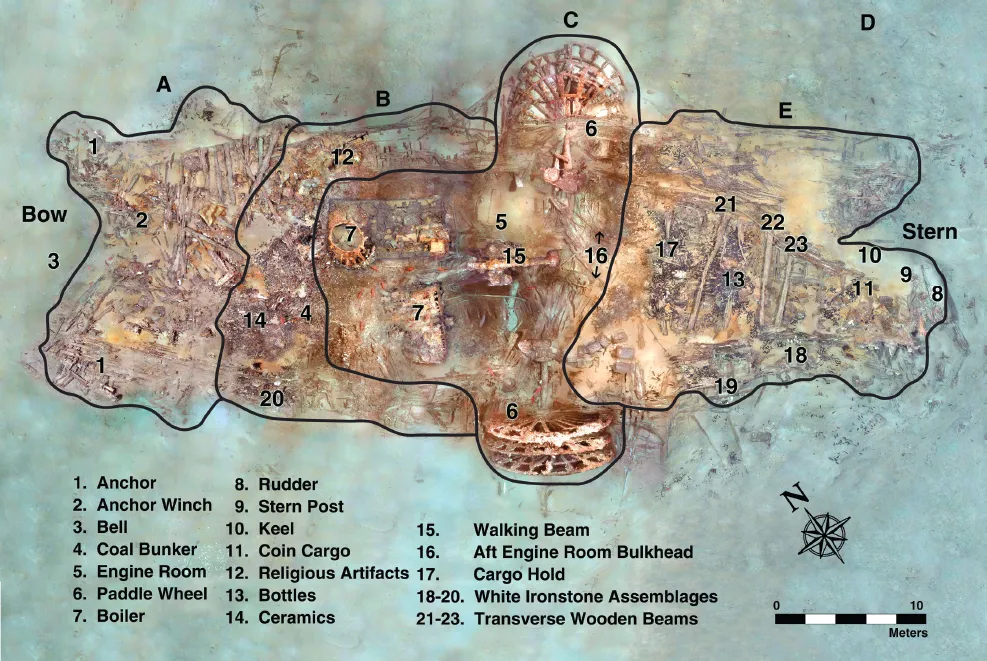![]()
The Shipwreck of the SS Republic (1865). Experimental Deep-Sea Archaeology. Part 1: Fieldwork & Site History
Neil Cunningham Dobson, Ellen Gerth & J. Lange Winckler
Odyssey Marine Exploration, Tampa, USA
Between October 2003 and February 2005, Odyssey Marine Exploration surveyed and conducted an extensive excavation on the shipwreck of the 19th-century sidewheel steamer the SS Republic at a depth of approximately 500m in the Atlantic Ocean, over 150km off the southeastern coast of the United States. The Republic was en route from New York to New Orleans with passengers and a composite commercial and monetary cargo when she foundered during a hurricane on 25 October 1865.
Some 262 ROV dives took place on the Republic, accumulating approximately 3,500 hours of bottom time on the seabed. 16,000 digital still photographs were taken and over 3,000 hours of video footage recorded. During the archaeological excavation 14,414 artifacts and 51,404 coins were recovered, recorded and conserved. These assemblages have produced a unique image of daily life in post-Civil War America, unparalleled in scale and diversity on any wreck of a steamship. The project provided an opportunity to develop and experiment with advanced robotics, navigation, photographic and excavation methods and techniques on a Remotely-Operated Vehicle (ROV) for the nascent discipline of deep-sea shipwreck archaeology. Part 1 of the report focuses on fieldwork, the wreck’s site formation and the history of the Republic.
© Odyssey Marine Exploration, 2010
1. Introduction:
The SS Republic Project
Between October 2003 and February 2005, Odyssey Marine Exploration (OME) investigated the shipwreck of the SS Republic, a 19th-century sidewheel steamer lost in a storm in the Gulf Stream of the Atlantic Ocean off southeastern America on 25 October 1865. This previously undiscovered deep-sea shipwreck, located at a depth of around 500m, was investigated using remote techniques in order to fulfil an interlocking set of scientific, archaeological, technical and commercial objectives:
1. | To assess the archaeological level of preservation, the character and site formation of the vessel and cargo. |
2. | To develop new technology and techniques for the survey and excavation of a shipwreck in deep water through the exclusive use of a Remotely-Operated Vehicle (ROV). |
3. | To produce non-disturbance photomosaics of the shipwreck site. |
4. | To systematically excavate and recover a sample of the ship’s unique commercial cargo, including a major consignment of coins. |
5. | To reconstruct the commercial orbit of the SS Republic’s final voyage through reference to the wreck’s historically unattested cargo and in relation to economic life in New Orleans in the immediate aftermath of the American Civil War. |
In the 30 years since scientists and marine archaeologists realized that deep-water technology exploited by the petroleum/gas and sub-sea cable industry – manned submersibles, ROV’s and electronic survey/navigation systems – could be adapted for scientific and archaeological investigation (Bascom, 1976), progress has been continuous. Significant deep-sea archaeological investigations have included wreck surveys and excavations in the Florida Strait (Kingsley, 2003), conducted in the Mediterranean and Black Sea (Ballard et al., 2000; Delaporta et al., 2006; McCann, 2001), the Norwegian Sea (Sóreide and Jasinski, 1998) and the Gulf of Mexico (Ford et al., 2008). These successes were rooted in interdisciplinary collaborative initiatives between archaeologists, scientists, the commercial sector and engineers familiar with the latest underwater systems and available technology.
During the summer of 2003, the Odyssey Explorer discovered a target believed to be the SS Republic. A side-scan image clearly depicted two paddlewheels flanking the sides of a vessel, a walking beam engine standing proud of the seabed, two boilers and remains of a wooden hull (Fig. 1). The absence of sharp contours suggested that the target was not a steel wreck. The image was closely analyzed and compared against the known historical record for ship losses in the area. The dimensions and features visible on the side-scan sonar very closely matched those of the Republic, as documented through historical research (Fig. 2). A visual survey of the site was conducted by an inspection ROV and an Admiralty arrest claim sought to protect the wreck. A project plan was then developed for the investigation of the target and an initial pre-disturbance survey initiated to attempt to identify the site conclusively.
The shipwreck is located approximately 150km off the coast of Georgia on a deep shelf of the Gulf Stream’s North American continental shelf. The Republic settled on a southeast to northwest axis at an average depth of approximately 500m. The seabed sediments are composed of terrigenous particles formed by the weathering of rock once situated on land and the remains of calcareous and siliceous shells. The site retains the classic elliptical shape of a ship (Fig. 4).
The observed shipwreck measures 65.5 x 30.0m within a principal wreck area of 1,965m2. Including the surrounding debris field to the north and south of the stern section of the wreck, the site extends across 56,726m2 (Fig. 9). It can be characterized as a continuous and coherent wreck, with articulated structural remains and cargo and a large debris field to the north and south of the stern half of the wreck. However, the upper layers of sediment and the strong 1-5 knot currents crossing the seabed have caused considerable abrasion, erosion and destabilization. The swift, deep currents present in the lower depths of the Gulf Stream have displaced part of the cargo and the wooden and metallic ship structure across the debris field.
More than 262 ROV dives took place on the Republic, accumulating some 3,500 hours of bottom time. Some 16,000 digital still photographs were taken and over 3,000 hours of video footage recorded. During the archaeological excavation, 14,414 artifacts were recovered, recorded, logged and conserved. A further 51,404 coins were recovered.
The platform used for the project was the 76m-long, 1,431-gross-ton dynamically positioned ship the Odyssey Explorer. For this project, the vessel was re-fitted to accommodate an ROV system, while working space was altered to support archaeology, data acquisition, logging and first-aid conservation. The vessel held accommodation for a crew and staff of 40 people. For the Republic project Odyssey modified a state-of-the-art ROV, manufactured by Soil Machine Dynamics Ltd. and renamed Zeus. This system was adapted for survey measurement, photography, manipulation and excavation. The 3.7 x 3.1 x 2.38m, 7.26 metric ton ROV was capable of operations of sustained duration down to depths of 2,000m (Fig. 5).
Fig. 1. Side-scan image of the wreck of the SS Republic.
Fig. 2. Reconstruction of the sidewheel steamer Republic based on a painting of the SS Tennessee in the Peabody Essex Museum, Salem, Massachusetts. Painting: by John Batchelor.
Fig. 3. The bell of the Republic in situ still retained its former name, the SS Tennessee.
Fig. 4. Photomosaic of the wreck of the Republic.
Fig. 5. The 7.26-ton, 3.7m-long ROV Zeus used during the survey and excavation of the Republic.
Fig. 6. Electronic grid imposed over the wreck site for contextual recording during excavation.
Fig. 7. Bathymetric site plan and scatter plot of artifacts (stern at right).
Fig. 8. The starboard paddlewheel in situ.
Fig. 9. Photomosaic displaying survey/excavation areas and the locations of prominent archaeological contexts.
Zeus was fitted with two Schilling Conan seven-function master/slave manipulator arms on either side of the front of the vehicle. The manipulator arms had a reach of 1.79m, a working arc of 120º and a lifting capacity of 170kg at full extension. The master/slave feature enabled the manipulator arms to duplicate in seabed operations the movements of the operator based in the research ship. Tools were deployed from stowage positions in various points on the vehicle.
For excavation and artifact recovery, the ROV was fitted with a venturi-effect suction device, a limpet suction device and a specialized sediment sifting and collection unit (for more details of this technology, see Cunningham Dobson et al., 2009: 3-6). The nozzle end of the venturi is operated by the starboard manipulator arm, allowing controlled excavation, and sediment is ejected through a hose at the rear of the ROV. Delicate artifacts were retrieved using a silicone rubber limpet suction device, which consisted of a soft bellows-shaped tube with a small suction pad at its end available in different sizes from pads of 2-10cm in diameter (Figs. 10-11).
On the wreck of the Republic Odyssey conducted a phase of developmental deep-sea shipwreck archaeology using the ROV Zeus, experimenting with new systems, techniques and equipment to assess a work ROV’s capability to perform archaeological surveys and excavations remotely at depth to acceptable comparative archaeological practices and standards. It is important to bear in mind that no guides existed, or have any been formulated to date, for this field of archaeological science. Research was conducted as 24-hour operations for 21-28 days at a time (weather permitting), before returning to port for fuel and water. Personnel typically worked 12-hour shifts on a two-month on, one-month off rotation.
Alo...



